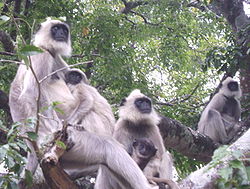Langur: Difference between revisions
No edit summary |
WikiDwarfBOT (talk | contribs) m (→References: Replace {{Source}} tag) |
||
| (3 intermediate revisions by 3 users not shown) | |||
| Line 1: | Line 1: | ||
{{Taxobox | |||
| name = Gray langur<ref name=msw3>{{MSW3 Groves|pages=174–175|id=12100693}}</ref><br />( or Hanuman Langur<ref name=menon>{{cite book|title = Indian Mammals, |author = Vivek Menon | display-authors = etal | |||
|publisher = Dorling Kindersley|year = 2003}}from the entry on Hanuman Langur, p.37: "There are several races of Hanuman langur, differing in colour and size. Scientists are currently debating whether this langur is a single species with several sub-species, or whether these are different species."</ref>) | |||
| image =MNP Grey Langeurs family.JPG | |||
| status = LC | |||
| trend = down | |||
| status_system = iucn3.1 | |||
| image_caption = Gray langur family at Mudumalai National Park | |||
| regnum = [[Animal]]ia | |||
| classis = [[Mammal]]ia | |||
| ordo = [[Primate]]s | |||
| familia = [[Cercopithecidae]] | |||
| subfamilia = [[Colobinae]] | |||
| genus = '''''Semnopithecus''''' | |||
| genus_authority = [[Anselme Gaëtan Desmarest|Desmarest]], 1822 | |||
| range_map = LangurMap.svg | |||
| range_map_caption= Rough distributions of the species | |||
}} | |||
The '''Gray langur''' or '''Hanuman langur''' ('''''Semnopithecus''''') is a [[genus]] of [[colobine]] [[monkey]]. They are found in [[southeast Asia]]. The word "langur" means 'having a long tail'. It is commonly called the '''leaf monkey'''. They usually live in small groups of between 2 and 10 individuals. They mainly eat [[leaf|leaves]], as well as some [[fruit]]. Langur spend most of their time in [[tree]]s. They have [[white]] [[fur]] and [[black]] [[face]]s. They are considered sacred animals therefore the "National social mammal of India". | |||
== References == | |||
{{reflist}} | |||
{{-}} | |||
{{biology-stub}} | |||
[[Category:Old World monkeys]] | |||
[[Category:National symbols of India]] | |||
{{simple-Wikipedia}} | |||
Latest revision as of 20:56, 30 April 2021
The Gray langur or Hanuman langur (Semnopithecus) is a genus of colobine monkey. They are found in southeast Asia. The word "langur" means 'having a long tail'. It is commonly called the leaf monkey. They usually live in small groups of between 2 and 10 individuals. They mainly eat leaves, as well as some fruit. Langur spend most of their time in trees. They have white fur and black faces. They are considered sacred animals therefore the "National social mammal of India".
| Gray langur[1] ( or Hanuman Langur[2]) | |
|---|---|

| |
| Gray langur family at Mudumalai National Park | |
| Scientific classification | |
| Kingdom: | |
| Class: | |
| Order: | |
| Family: | |
| Subfamily: | |
| Genus: | Semnopithecus Desmarest, 1822
|

| |
| Rough distributions of the species | |
ReferencesEdit
- ↑ Groves, C. P. (2005). Wilson, D. E.; Reeder, D. M. (eds.). Mammal Species of the World: A Taxonomic and Geographic Reference (3rd ed.). Baltimore: Johns Hopkins University Press. pp. 174–175. ISBN 0-801-88221-4. OCLC 62265494.
- ↑ Vivek Menon; et al. (2003). Indian Mammals,. Dorling Kindersley.from the entry on Hanuman Langur, p.37: "There are several races of Hanuman langur, differing in colour and size. Scientists are currently debating whether this langur is a single species with several sub-species, or whether these are different species."
